

ARCHITECTURAL HISTORY
Joel Sanders
This design history of the Western bathroom, from antiquity until the 21st century, challenges the prevailing assumption that bathroom design is shaped by function as dictated by biological and technological parameters. It is a complex narrative shaped by a series of political, economic and technological forces that are driven by changing cultural conceptions about the nature of health and hygiene, privacy and propriety, rich and poor, sex, race and gender identity.
Read Essay
Barbara Penner: “Far from being straightforward pieces of technology, then, bathrooms are culturally determined and historically specific.”1
Slavoj Zizek: “As soon as you flush the toilet, you’re in the middle of ideology.”2
Moving forward means looking back. Accomplishing the mission of creating safe inclusive restrooms that meet the needs of a diverse range of people of different ages, genders, religions and disabilities requires us take a broad view. We must consider restroom design in a social and historical context to understand how we came to the impasse we are at today.
History is an instrumental tool, a testimony to the fact that the future can be different from the present. The creation of public spaces that foster diversity and inclusion depends on first identifying and then overcoming the deep-seated historical and ideological forces that have shaped the design of the spaces of our everyday lives. However, architecture is an inherently prescriptive and prospective discipline: we create blueprints for future human habitation. History is a point of departure for envisioning alternative futures.
There is a vast literature devoted to the history of bathrooms that traces their evolution, primarily from an Anglo-American perspective. A wide range of authors representing different fields — from architectural history to psychoanalysis — have explored this rich territory from a variety of theoretical, social, economic and technological perspectives. (see Stalled! bibliography at the end of this paper). This is not a dispassionate account. Rather this whirlwind overview is polemical: it synthesizes selected highlights culled from different sources to challenge preconceptions about a quotidian space — the sex-segregated restroom — whose design we tend to take for granted as universal and inevitable. My aim is to dispel the prevailing assumption that bathroom design is shaped by function as dictated by biological and technological parameters. Instead I hope to demonstrate that its design history is historically and culturally relative, a complex narrative that takes into consideration an interconnected series of political, economic and technological forces that are driven by changing cultural conceptions about the nature of health and hygiene, privacy and propriety, rich and poor, sex, race and gender.
The structure of this historical summary mirrors the bifurcated history of bathroom architecture: until the 19th century, washing and eliminating were spatially separated until the advent of the water delivery systems made possible by underground sewers in the late 19th century. Therefore, this narrative is divided into three sections. The first two present parallel chronologies of the spaces that accommodated washing and eliminating from antiquity to the 19h century. The third section, devoted to 19th and 20th century restroom design, discusses how these two bathroom practices were for the first time consolidated into one room. This joining established the configuration we use today and how modern architects refined the type to address deep-seated social anxieties about the “abject” bodily substances discharged from bodies into bathrooms. Although Stalled!’s focus is ultimately on the public restroom, this history treats public and private bathrooms as intertwined narratives that need to be considered in relationship to one another.
Note that this chronology of restroom practices is Western-centric and does not take into account the spatial accommodation of non-Western bathroom practices. Since the immediate goal of Stalled! is to change restroom policies in the United States, we decided it was better at the outset to narrow our focus to the Western precedents that shape our own restroom traditions. However, Stalled! hopes to expand our research to explore the history of the bathroom from a global perspective. This is a vast and rich territory that requires future scholarship beyond the relatively small body of work devoted to this subject in English.
PART 1: WASHING
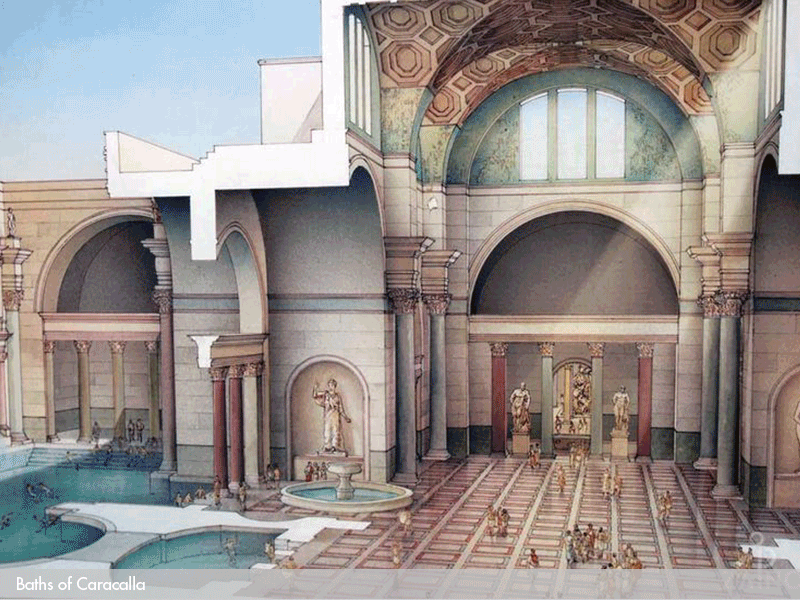
ANTIQUITY TO MIDDLE AGES
Over the course of human history, washing, a practice we today associate with hygiene, has come in an out of fashion.
Historians describe how from the Roman Empire to the Middle Ages, men and women washed in communal bathhouses. Open from lunchtime to dusk, Roman baths, like the Baths of Caracalla and Diocletian in Rome, were feats of architectural engineering famous for their wide span barrel vaults and monumental domes clad in sumptuous marbles and mosaics and fed by water supplied by aqueducts. Built and run by the state, they were a common daily destination for all classes of Roman men and women to wash as well as socialize. These multi-purpose buildings not only incorporated a variety of cold, warm and hot pools but also amenities like shops, gyms, and libraries. Some could accommodate more than 8,000 people at a time.
Baths were co-ed: while some Republican bathhouses had separate facilities for men and women, other respectable establishments accommodated nude mixed bathing, a common practice referred to in Martial, Juvenal, Pliny and Quintilian. While scholars debate the prevalence of mixed bathing, several imperial decrees against co-ed bathing were issued by emperors, such as Hadrian, indicating that this practice was widespread, a matter of personal choice that varied between persons, region, and establishment.
During the Middle Ages, the Church condoned cleanliness and hygiene as Christian virtues. Kings, knights, and the aristocracy enjoyed ritual scented baths at home in wooden tubs covered in linen cloths to prevent splinters. Commoners visited co-ed public bathhouses where men and women bathed in communal tubs, often perfumed with herbs and spices and draped in tents to retain steam. At some, customers dined, eating meals off boards laid across the tubs.

RENAISSANCE TO THE ENLIGHTENMENT
But for nearly 200 years, from 1500-1750, during the Renaissance and Protestant Reformation, there was a virtual washing moratorium. The decline was the result of two factors: morality and pre-scientific conceptions of contagion. Bathhouses became associated with houses of ill repute and were closed. People believed diseases like syphilis were spread by polluted water as well as “miasma,” foul odorous air emanating from poor sanitation, cramped quarters and dirty clothes. According to common wisdom, washing accelerated illness by allowing both water and air-born diseases to penetrate human pores and orifices. As a consequence, public baths were closed and washing was conducted in private. Rather than immerse their bodies in dangerous water, people wore clean linens that absorbed body secretions. As personal washing was replaced by laundered clothing, appearance became more important than hygiene. Etiquette and medical manuals advised people to wash only the parts of the body that were visible to the public — face, neck and hands — and to mask offensive body odors with perfume. Spotless white linen collars and cuffs were a visible sign of affluence, social status and absorptive cleanliness.
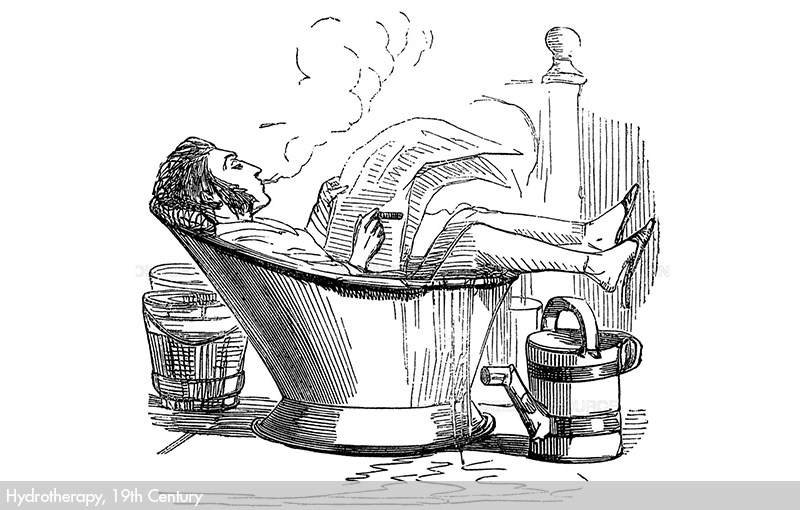
19TH CENTURY
By the mid 19th century, the convergence of Victorian-era values and advances in medical science led to the rehabilitation of washing in Great Britain and North America. There, the middle class developed an ideology of cleanliness that equated personal hygiene with Christian purity, morality, and respectability. Two influential physicians, Dr. James Currie and Sir John Floyer, argued that frequent bathing was therapeutic. Its healing properties led to the opening of Turkish-style baths, inspired by Orientalism, a fashion for “exotic” design elements borrowed from the European colonies and their neighbors.
At the same time, medical science discovered that diseases like cholera were spread by contaminated water: this motivated socially minded municipalities to invest in the construction of urban sanitation systems in the interest of public health. Simultaneously, a new industry provided the first manufactured bathroom fixtures to the middle classes. With the confluence of these cultural, technological and economic forces, the reputation of bathing changed: it was redeemed as a healthy practice, now conducted in private homes by the upper and middle classes.
Before the arrival of plumbed bathwater in 1860’s, the affluent relied on servants to carry heavy buckets of hot water from basements to bedrooms to fill and empty porcelain jugs, basins and chamber pots. But by the end of the century, private bathrooms with hot running water became increasingly common in middle-class American and British homes. Body odor, a sign of class divisions, could be overcome; everyone was entitled to smell like a well-groomed aristocrat.
PART 2: ELIMINATION
In the History of Shit Dominque Laport describes how from antiquity until the Middle Ages, human excrement was considered dirty and foul smelling but did not elicit the intense feelings of shame and disgust that it does today. Although access to waste management was a function of class privilege, no matter one’s social station, coming into contact with urine and feces was an unavoidable part of everyday life.
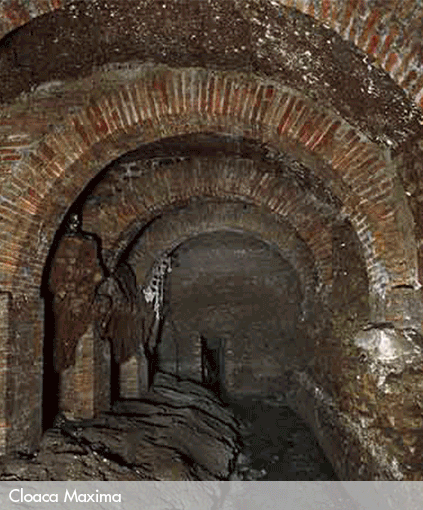
ANTIQUITY AND THE MIDDLE AGES
Sewer systems like the Cloaca Maximus in Rome were engineering marvels that flushed waste from the private homes of the wealthy and the ground floor latrines of some apartment buildings through a central channel into the main sewage system and into a nearby river or stream. However, for the most part people dodged waste thrown into the street. The Dejecti Effusive Act paid damages to people injured during daytime incidents.
Romans of all ages defecated in communal latrines that many archeologists believe were co-ed. Located in urban centers, latrines were architecturally distinctive facilities, often adjacent to gardens that accommodated from four to fifty people, making defecating a social activity. Latrines were large rectangular rooms, covered but open at the center for ventilation and lined on their perimeter with continuous wood or stone benches with keyhole-shaped openings. Water flowed in troughs beneath the seats, conveying waste to the municipal sewer system. After eliminating, Romans cleaned themselves by using a shared sea sponges on a stick dipped in vinegar. Some latrines were elaborately decorated with marble revetments, mosaics and frescoes including one famous for depicting philosophers engaged in a philosophical debate while eliminating.
During the Middle Ages, bathroom etiquette continued to be class based. Castles were equipped with garderobes. Holes placed in the floor of these closet-like indentations inserted into the thickness of exterior walls dropped human waste into cesspits below. The word “garderobes” derives from their dual function as places to store clothes in an ammonia rich environment that killed fleas.
Hampton Court exemplifies the hierarchical nature of eliminating for European aristocrats from the Middle Ages through the 18th century. Royalty used a “close stool”, a padded seat placed over a pewter or ceramic chamber pot often located in a dedicated room with discretely placed doors, one adjacent to the bedroom and the other to the hallway for efficient waste removal by servants. Lesser nobles used a personal chamber pot. Everyone else used the “Great House of Easement,” communal mixed sexed facilities that discharged waste into tanks cleaned by waters from the castle moat. It was not only the lower classed that defecated in public: members of the royalty or royal individuals could opt to perform their daily eliminations in rituals attended by courtiers, the “Groom of the Stool.”
Although they lacked the sophisticated urban sanitation infrastructure that characterized the Roman era, historian Carole Rawcliffe describes how Medieval towns were committed to funding and maintaining public toilets, named “pissyngholes” and privies. Civic government and individuals made donations and bequests to assist in their upkeep. Many were large facilities where people of both sexes defecated through holes inserted in bridges that deposited human waste into the rivers below. Whittington’s Longhouse located on Greenwich Street, London accommodated 84 seats. However, for the most part, human waste was thrown directly into filthy city streets, a practice that would continue until the introduction of sewage systems in the 19th century.
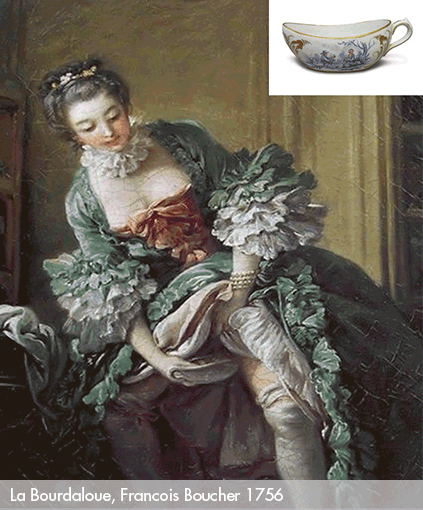
ENLIGHTENMENT
Attitudes about elimination shifted dramatically during the Enlightenment: the emergence of the notion of the autonomous individual put a premium on personal modesty, especially between the sexes. Before, it was frowned upon but still common for people of all social classes to urinate and defecate indoors — in fireplaces and hidden corners — as well as outdoors — in streets and alleys — in full view of others. However, by now these practices were considered objectionable if not downright disgusting. For example, one etiquette manual dictated that it was no longer appropriate to engage in conversation with people squatting in the street.3 For the first time, body parts and human waste were considered shameful elements that needed to be concealed from view. Eighteenth century women’s fashion was designed with modesty in mind: aristocratic women could eliminate standing in public by discretely hiding a “bourdaloues,” a porcelain boat-shaped receptacle placed under their voluminous skirts.

19TH CENTURY
Flushing toilets exemplify how the acceptance of technological innovations can be driven by shifting social attitudes. Although Sir John Harrington installed the first flushing toilet at his home in Bath in 1596, it did not become popular until the Great Exhibition of 1851, where one mass-produced by Thomas Crapper was famously displayed. Some attribute its delayed adoption to lack of easy access to running water and social convention: well-bred women did not want to be seen leaving their bedrooms to eliminate in toilets located in corridors. Instead, chamber pot waste was collected in cesspits and carried off by “night-soil” men for use as manure. Raw sewage was drained in rivers.
However, the confluence of shifting values and advances in medical science spurred technological developments: Victorians came to value personal hygiene and modesty and the discovery that water, not foul air, conveyed disease led to the prioritization of plumbing over ventilation. However it took a health crisis, the Great Stink of 1858, to trigger the construction of London’s extensive urban sewer system. Running water coupled with the advent of the mass produced sanitary-ware paved the way for domestic toilets to become an affordable necessity for the upper and middle-classes. For the first time, two previously segregated activities — washing and eliminating — were brought together into one enclosed room, the private bathroom that we take for granted today.
Affordable manufactured plumbing fixtures serviced by public sanitation systems resulted not only in the birth of the domestic bathroom, but also made possible another significant development, the emergence of the first sex-segregated restrooms. As Professor and legal scholar Terry Kogan describes in his essay in the Code chapter of this website, American bathroom design was shaped by a “separate spheres” ideology, that confined women, considered the “weaker sex,” to the home while men, physically and intellectually stronger, were free to occupy public space. Men and women used privies, freestanding wooden enclosures typically located in domestic backyards. Some were single user, while others accommodated multiple family members, sometimes of both sexes, who eliminated together. However, by the mid-19th century, women were increasingly leaving home to take part in metropolitan cultural and retail activities as well as to work. This circumstance was perceived as a threat. In response, architects introduced women’s only spaces, including sex-segregated restrooms, in libraries, hotels, department stores and factories, conceiving of them as safe havens that protected vulnerable females from the pressures of the male public realm.
PART 3: THE MODERN BATHROOM
ABJECTION
By the turn of the 19th century, two activities — washing and eliminating — were consolidated into one enclosed room configured into two standard restroom types that have come down to us until this day: the private domestic restroom and the sex-segregated public restroom. Over the course of the 20th century, their designs were refined as modern architects and product designers responded to emerging cultural anxieties about the “abject” body.
The feminist philosopher Julia Kristeva coined the term abjection to describe the discomfort induced when we come into contact with human waste, not only urine and feces, but also other bodily substances discharged into bathrooms, like sweat, saliva, mucus, vomit and blood. Numerous thinkers including Sigmund Freud, Luce Irigaray, John Paul Sartre, Mary Douglas and Elizabeth Grosz have provided a variety of explanations for the anxious feelings triggered by abjection. Human by-products are threatening because unlike solid materials that are stable and easy to control, bodily fluids are inherently unstable substances that resist containment.
Bodily fluids conform to an abjection hierarchy or gradient categorized by fluidity and color: clear liquids, like tears, saliva, and sweat are generally considered somewhat less disgusting than those which are unclear, colored and viscous, like urine, pus, mucus, vomit, blood, menstrual blood and feces. Although they vary in texture and appearance, abject substances share a common characteristic: they are deemed unclean. But as Mary Douglas argues, there is nothing inherently dirty about dirt. Dirt is a cultural construction, “matter out of place,” which “offends against order.”4 For this reason, viscous elements are considered especially repellent because they exist in a borderline, indeterminate state between solid and fluid that challenges our sense of order and control. And making matters worse, they are sometimes discharged by bodies that have themselves lost physical control due to illness, oldage, disability or death.
Worse yet, these uncontainable viscous fluids not only violate our urge for order, they underscore the porosity and vulnerability of the body. We tend to comfort ourselves by conceiving of the human skin as an impervious membrane that functions like the facades of buildings; a continuous surface that encloses the body, the receptacle of the mind, and clearly differentiates us from the outside world. But bodily substances cross the boundary of the skin, flowing from inside to outside. Viscous substances like sweat, pus and blood, seep and ooze from pores and sores while urine, spit, shit, vomit and menstrual fluid are expelled from our orifices — nose, ears, mouth, genitals and anus — undermining our illusion of coherence. According to Grosz, “they affront a subject’s aspiration toward autonomy and self.”5 By transgressing the borders of the skin, secretions contradict the reassuring fiction that we are autonomous beings in full control of our lives, unsettling reminders that we are vulnerable, mortal material beings, made of flesh and blood.
Bodies become identified with and take on the abject qualities of the dirty fluids that they discharge — guilt by association. They in turn become abject, reviled for being intrinsically dirty, and polluting. As a consequence, abjection has been used to mark, marginalize and exclude people of different genders, races, classes and disabilities, who disrupt the social order. Abject fluids are implicitly associated with femininity, maternity, pregnancy, and menstruation, reinforcing the idea that women, like the bodily fluids they expel, are unclean and potentially contaminating. Religions, including Judaism, Hinduism and Islam prohibit sexual encounters with women during their menstrual period. Surveys show that the majority of Americans consider menstruation, referred to as “on the rag” or “the curse,” as shameful and embarrassing. Mood swings and irritability brought on by PMS reinforce the image of women as unstable as the fluids they emit; they are innately irrational and emotional victims of hormonal fluctuations they are unable to control. A double standard traditionally applies to two male bodily fluids — urine and semen — that in many instances have positive connotations because of their associations with masculinity. Urination is a way the male species has traditionally marked territory. Until the 20th century men, unlike women, were permitted to urinate in the streets. Paradoxically, semen, a translucent viscous substance that possesses all the characteristics of the abject, when associated with the act of ejaculation, is celebrated in locker-room talk and pornography.
In a similar vein, abjection has been used to perpetuate racism and homophobia. Non-white skin is considered by racists as dirty, an outward visual signifier of racial inferiority that historically has been used to affirm pernicious stereotypes that people of color are physically and often mentally diseased and deranged. American white supremacists justified Jim Crow laws that mandated segregated public spaces, including “colored” bathrooms, by arguing that black people exposed whites to contagious diseases like syphilis and that black men were sexual predators who threatened to pollute the purity of the white race through miscegenation.6 Likewise, one argument for discrimination against gay men is that they engage in anal sexual practices that are reviled for being unclean, and as a consequence unnatural. Fueling this anxiety is shame: pleasure derived from anal stimulation is considered taboo, reinforced by its correlation with non-heteronormative eroticism, making it especially threatening for many straight men. This deep-seated fear materialized during the AIDs crisis, when gay men were portrayed as carriers of disease who threatened to expose straight men to infectious bodily fluids in public restrooms.
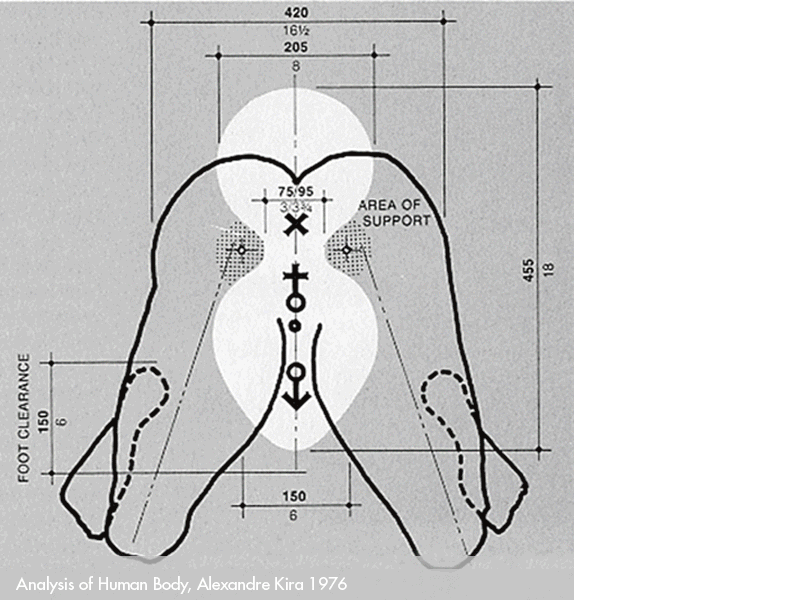
MODERNISM
Historians like Ian Miller have demonstrated that abject feelings triggered by bodily substances can be traced back to antiquity.7 He and others agree that the emergence of Victorian puritanical attitudes about the corporeal body, coupled with advances in medical science, led to the emergence of abjection as a full-fledged fear that captured the imagination of people — including designers — in the late 19th and early 20th century. No wonder that the reputation of bathroom,s and in particular public restrooms, became tainted. They were viewed as sites where people inevitably come into contact with abject substances discharged from their own bodies and those of stranger. In response, modern architecture came to the rescue. Architects like Le Corbusier and Adolf Loos famously enlisted bathroom design to overcome the threat of abjection. In their polemical publications, Le Corbusier and Adolf Loos celebrated what was at that time a new technology — plumbing and plumbing fixtures along with white shiny surfaces of stone, porcelain, or tile. Restrooms networked to urban infrastructural sanitation systems allowed architects to literally flush away the disease-spreading bodily secretions that plagued earlier urban European civilizations.
But rather than rely on technology alone, modern architects married waste management systems with aesthetics. Le Corbusier’s design for the master bathroom at the iconic Villa Savoye exemplifies how architects enlisted these dual strategies to overcome abjection through design.8 Antiseptic modern bathrooms allowed users to disown their mortal flesh and its by-products through concealment. Mass-produced sinks and toilets were designed with discretely placed drains to eliminate the visual and olfactory evidence of waste. Le Corbusier published diagrams that compared a building’s mechanical services — air handling and plumbing — to the human respiratory, circulatory and excretory systems. Both non-human and human systems, which cater to needs of the corporeal flesh, are hidden from view, concealed in cavities behind the skins that clad people and buildings.
For Le Corbusier, display works hand-in-hand with concealment. In publications, the architect included photographs of the Villa Savoye’s innovative master bathroom, which he treated not as a conventional enclosed water closet but as an open precinct clad in antiseptic tiles, that in many ways anticipates today’s bathroom spas. It is divided from the master bedroom only by a raised tiled platform that incorporates a built-in tub and a tiled wall whose curvilinear contour resembles a chaise lounge. When seen from the master bedroom, this sculptural ensemble frames a view of mass-produced fixtures dedicated to washing — sink and bidet — which Le Corbusier treats as icons displayed against a backdrop of gleaming white tiles. The impervious, easy-to-clean, supposedly germ-resistant porcelain surfaces of these fixtures give the reassuring visual impression of cleanliness. Interestingly enough, the offending toilet remained discretely hidden in an isolated closet.
Hygiene is further reinforced by color. Rendered in bright white, the master bathroom fixtures and tiles match the paint color of the house. White is a color associated with religious and racial purity and historically associated with building types like churches, hospitals, and laboratories that promote health and well-being. According to Barbara Penner, during Le Corbusier’s era, white had explicit medicinal associations: white lime wash was applied to the walls of privies, cesspools and public urinals through the 19th century as a disinfectant to fight against cholera and typhoid. At the Villa Savoye, not only the design of the master bedroom but also the front entry is a testament to the conviction of Le Corbusier and his peers that architecture could triumph over abjection through the marriage of technology and design: the first object visitors encounter when they set foot in the foyer is a white porcelain sink.
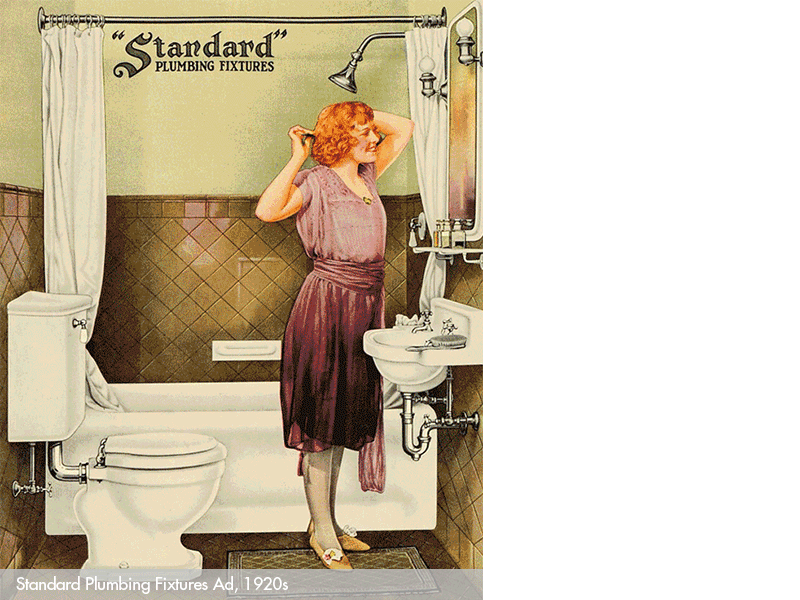
20TH CENTURY
By the mid-20th century, the hygienic bathroom was conceived as a women’s domain. Bathrooms reinforced the gendered division of labor associated with the rise of private suburban homes: women, confined to their homes, were seen as unpaid laborers who generated a relentless cycle of repetitive chores, preparing meals and cleaning for their families. Manufacturers seized upon a lucrative opportunity to sell products targeted to female middle class consumers. Hence the “soap opera” on television, a genre named for its sponsors. In publications like House and Garden, ads put pressure on women tobuy the latest bathroom fixtures and products to prove they were worthy housewives capable of upholding unprecedented standards of cleanliness once reserved for hospitals. Mass marketing campaigns married consumption, aesthetics and hygiene, applying the principle of built-in obsolescence from automobiles to bathroom interiors: product designers like Raymond Lowey periodically rolled out lines of bathroom fixtures in colors that mirrored trends in ladies fashion. The ritual of the once-a-week Saturday night bath was replaced by the daily shower or bath promoted as an emblem of domestic hygiene by bathroom advertisements.9
By the post-war period, the media, including Hollywood films, touted bathrooms not only for their hygienic attributes but also as sites for relaxation, pleasure and seduction. In Pillow Talk, Rock Hudson and Doris Day flirt on the telephone as they soak in bathtubs. Bathtub seductions are a staple in James Bond films like Thunderball and Moonraker. Today, as we spend more and more time with our digital devices navigating virtual space, bathrooms have become more important than ever before in the American imagination: they have been recast as home spas, retreats where we can reconnect with our embodied selves.
DEMISE OF THE PUBLIC RESTROOM
The restroom, a quotidian space that we take for granted, has a long and complicated history driven by the intersection of technological innovation (plumbing and manufactured fixtures) and the rise of puritanical conceptions about the body associated with the birth of the bourgeois subject. Over the course of two millennia, two practices, washing and eliminating, once conducted in separate locations in communal mix-sexed facilities or outdoors in city streets, are merged in one enclosed room, now relegated to the domestic interior where they are reconceived of as activities that are best performed by individuals in the privacy of their own homes.
The rise of the private bathroom coincides with the decline of the public restroom. The first public toilets unveiled at the Crystal Palace were a popular sensation and copied in cities across Europe and America. However, public toilets, formerly considered a required feature of any civilized 19th European or American metropolis, became scarce by the 20th century. No longer considered an essential component of the public realm as it was from the antiquity to 19th century, by the 20th century restrooms became a necessary evil, a concession to biological need, a destination we are forced to use when we are not at home. In fact, in America the “public restroom” is a misnomer: today, if you can find them, they are limited access amenities, available only to patrons who are granted access to the private buildings in which they areusually located — offices, restaurants, theaters, and malls. The few remaining truly public bathrooms tend to be found in transportation hubs and are considered places to avoid: filthy, disease ridden and dangerous places frequented only by social outcasts — prostitutes, homosexuals, the homeless, and the abject poor. Starbucks drew national headlines in May 2018 when, after being accused of racial discrimination, it announced its bathrooms would be open to all customers, even those who have not made a purchase, in its 14,000+ U.S. locations.
HISTORICAL LESSONS
What lessons can be derived from this cultural design history of the bathroom? Recognizing that bathroom designs like the practices they accommodate are culturally and historically relative challenges our preconceptions and encourages new thinking. The variety of iterations that bathrooms have assumed challenges the prevailing modernist myth that the bathroom is the quintessential functionalist face determined by seemingly objective and natural technical, physiological and psychological considerations. Historical precedent proves that we need no longer accept the sex-segregated restroom as an historical inevitability: examples from communal Roman and Medieval bathhouses and latrines to American backyard privies shared by families, dispels the prevailing myth that sex-segregated restrooms answer to a universal need for privacy between the sexes. It refutes the central argument cited by opponents to transgender access to public restrooms that formed the basis of the brief opposing Title IX protections for trans people in the Gavin Grim case that was intended to be heard before the Supreme Court. Instead, history demonstrates that the sex-segregated restroom is a Victorian invention, based on the problematic assumption that women were emotionally and physically vulnerable and needed to take refuge in female-only spaces when they ventured out of the home and into public space.11
The recognition that restroom design is determined by the complex entanglement of changing cultural conceptions of such seemingly objective criteria as function, technology, anatomy and psychology, encourages us to challenge and to jettison the deep-seated and often problematic assumptions about gender and abjection encoded in the sex-segregated restroom that we have inherited from the past. History becomes a liberating force that teaches us that the future need not be like the past. It invites us to give up outmoded codes and standards and to replace them with new and innovative design alternatives that register the complex, fluid and intersectional nature of race, class and gender in a way that meets the goals of social equity, diversity and inclusion.
Bathroom history cannot be ignored or dismissed entirely. We can in part go productively back to the future. Precedent reveals that design solutions that might at first glance appear to be radical — like the multi-user solution that Stalled! advocates in the Design chapter of this website — in some ways merely revives a commonplace condition found in 19th century hotels like the Tremont Hotel in Boston where everyone used unisex privacy stalls. And in the process of inventing alternative futures, we can be inspired by some of the great architectural examples of the past. Since Thomas Jefferson, American civic architecture has embraced the Roman classical tradition. Why can’t we learn from the Roman Baths and invest government resources in projects that reconceive public restrooms as key components of the public infrastructure? Rather than treat them as single-purpose spaces where we go to perform activities that we are taught to be ashamed of as we do now, could we follow in the footsteps of the Romans, and reconceive restrooms as architecturally distinctive multi-use social destinations where people of different classes, identities and embodiments mix?

BATHROOM POLITICS
Susan Stryker
This essay contextualizes recent national restroom debates in a social-political context, demonstrating that at different moments in American history the public restroom has been a crucible that has registered the social anxieties triggered by the threat of a series of marginalized groups entering into mainstream society including women, African-Americans, gay men, and the disabled.
